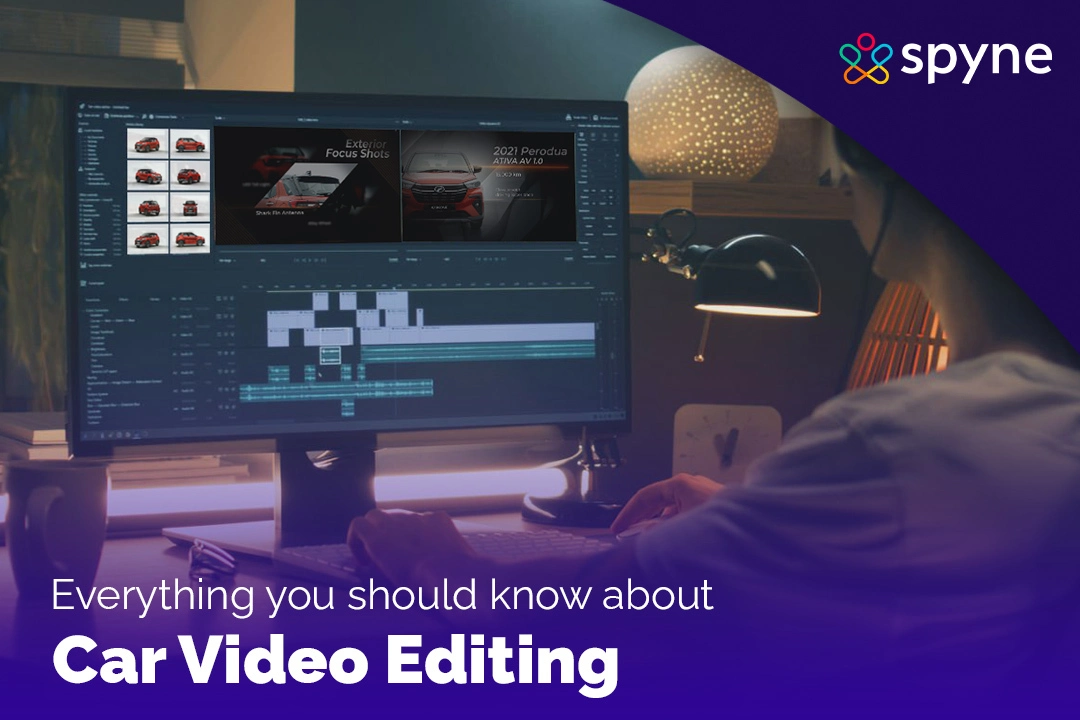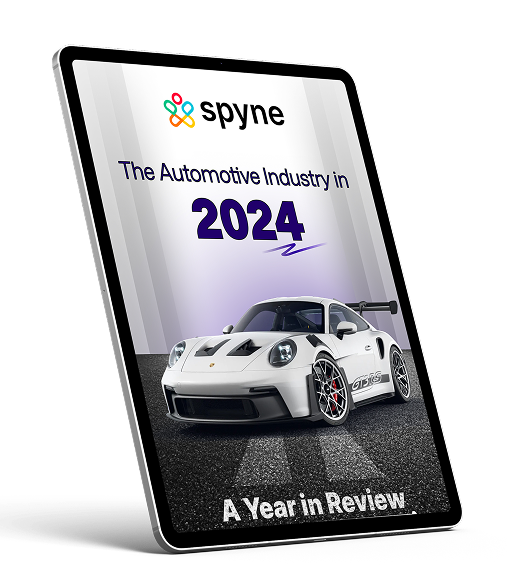Ever tried to edit a car video? If yes, then you know it can be more complicated than it seems. It’s not just about cutting clips or adding audio; it’s enhancing every frame to highlight the vehicle’s features, creating an engaging story that intrigues the buyer. This is where car video editing comes into play. Whether you are an expert in the automotive world, a social media influencer, or an enthusiastic enthusiast, the right editing of your car videos is the magic that can be used to make raw footage look like cinematic gems.
In this blog, we’ll go over the tools, creative techniques, and practical tips that will guide you in transforming your footage into engaging videos.
Understanding Car Video Editing Tools
Video editing in cars is important in helping convert raw footage into a presentable and engaging content that tells a great story. Whether it is social media content, creating an advertisement, or just for personal projects, deciding on the best tools to edit will help you achieve a professional look and feel. From simple edit to complex effects, quality tools will get you creating stunning car videos that catch the eye. Here are the features that your car video editing software must have

Basic Editing Functions
The heart of any car video editing tool would include basic features like cutting, trimming, and arranging clips. These enable you to assemble your footage seamlessly into a coherent narrative. Ensuring that the transitions between shots are smooth is especially important when transitioning between different scenes, such as from a close-up of the car’s features to a wide shot on the road.
Stabilization & Motion Tracking
It is very normal to have shaky footage, especially when shooting on the move. Stabilization features help stabilize shaky footage to give your car footage for editing a really polished, professional look. Car videos also benefit from motion tracking, which makes it possible for you to emphasize certain parts of the vehicle moving, such as the wheels or headlights, thereby making the video more interesting and dynamic.
Speed Control & 3D Effects
A car’s speed ramps and slow-motion features allow for a much more dramatic shot of the high-speed scenes as well as providing more impact when taking detailed shots. 3D effects create another level of creativity, giving you the capability to show a car in visually striking ways-be it a rotating view or even a dynamic background.
Color & Sound Enhancement
Color correction is essential to make the car and its surroundings look their best. Whether you want to enhance the natural hues or give the video a cinematic feel, adjusting the color balance can make a big difference. Sound is equally important, from engine roars to background music, audio editing tools help enhance the mood and intensity of your video, complementing the visuals perfectly.
Platform Optimization & HD Support
Today’s videos need to look great on various platforms, from Instagram to YouTube. Editing software should allow you to adjust the aspect ratio to fit different screen sizes and ensure the video is optimized for the platform you’re publishing on. High-definition support is also a must, especially if you’re filming in 4K. Crisp, detailed shots will highlight the finer details of the car, such as its design, performance, and features.
While these features require tremendous skills and equipment today, AI based video editing platforms like Spyne’s auto video maker give the power to everyone to easily edit their car videos with simple steps.
The Essentials of Car Video Editing
Regardless of the type of car video you are working on, there are a few basic elements of editing that will ensure your video is professional and visually stunning. Some of these are:
Video Stabilization
One of the most common issues with car video footage is shakiness. Whether you are filming from a moving car, using a handheld camera, or working with car videography cameras, stabilizing your video is essential. Most editing software offers a stabilization feature that automatically smoothes out shaky footage. For more advanced work, you can manually adjust the footage for even better results.
Color Grading
Color grading makes your car videos more striking in visual appeal. Car videos typically emphasize specific colors, such as a shiny metallic car finish, or evoke cinematic mood. Using AI tools like Spyne’s auto video clip maker helps you to fine-tune exposure, shadows, highlights, and saturation to create an image that feels much more finished.
Audio Editing
The big roar of an engine, a screech of tires or even the surrounding ambient noise play a huge part in the car video feel, but audio may sometimes be either too overwhelming and distorted. So, you would improve the audio by removing such background noises, adding effects or even sound designing where you may layer engine sounds, music and even voiceover for a fuller audio experience.
Cutting & Splicing
Editing is knowing what to leave in and what to cut out. A good car video should capture the best moments but not be too long or monotonous. It’s crucial to cut out unnecessary footage while maintaining continuity and rhythm. Editing software’s trim and splice tools will help you remove unwanted segments, keeping only the most engaging shots.
Creative Techniques for Car Video Editing
Once you have mastered the basics, now is the time to get creative. Adding those creative touches helps your video to stand out, engaging your audience.
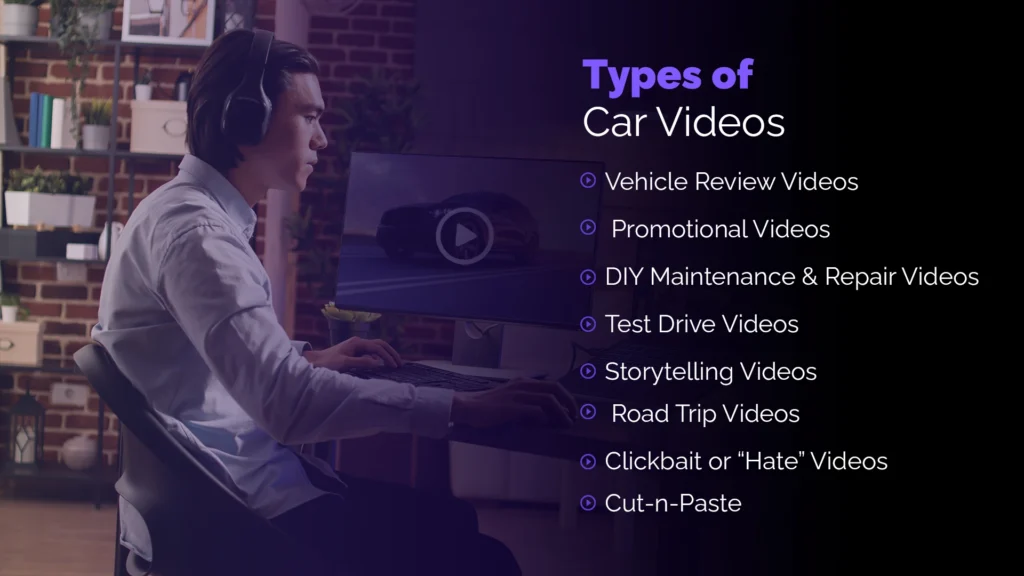
Slow motion & speed ramping
Slow-motion is a great tool in car videos, especially when you want to emphasize acceleration, sharp turns, or engine roars. Speed ramping, or changing the speed of a shot during playback, allows you to go from fast-paced action to slow-motion and back again, creating dynamic, visually engaging sequences.
Time-Lapse
If you are filming a long trip or a car in one location for some time, time-lapse can compress the footage into a more exciting process. You might be able to capture a fast-paced and aesthetically pleasing sequence of sunset or the car moving through the landscape.
Motion Graphics & Animations
You can include motion graphics such as logos, titles, and animations to quickly deliver information while providing a professional touch. For instance, including the model name of the car or speed metrics in a creative manner will help in enhancing the understanding of the video for the viewer while keeping it entertaining.
Drone Shots & Aerial Views
There is just something about the majesty of a car cruising through beautiful landscapes that is captured in drone shots. Aerial footage affords your video a cinematic quality and may help to highlight its car’s design and its surroundings.
Customizing Car Videos for Different Platforms
Every platform differs in specifications as well as viewer expectations. That’s why creating different versions for every platform helps to increase viewership and reach.
For Instagram, whose users love videos short and flashy, a square (1:1) or vertical (9:16) is ideal. Your car video can be limited to 60 seconds for a maximum engagement opportunity.
YouTube
Longer, more detailed videos work best on YouTube. Use the standard horizontal (16:9) format, and consider adding in-depth commentary or high-quality voiceover to explain car features or the video’s context.
TikTok
On TikTok, where quick, energetic content is king, aim for fast-paced edits and snappy transitions. A vertical (9:16) format is required, and keeping the video under 1 minute will help it perform well.
On Facebook, keep the videos very short (under 2 minutes) and be sure to make an impact immediately. The first 10 seconds are key in keeping them hooked.
AI-Powered Features in Car Video Editing
AI is pushing car video editing to new heights. With the advanced algorithms, AI-based editing tools like Spyne’s car video editing app can smooth out processes, enhance video quality, and even automate complicated procedures. Here’s how they are doing it:
Guided Video Filming
Though AI platforms are creating a more streamlined and guided car videography experience that empowers all people irrespective of their skills to create quality videos. The platform takes care of editing and enhancements and makes the process simple and easy. This makes it easy for any dealership’s fleet manager or sales person to churn out high quality car videos.
Automatic Scene Detection
With AI, dealerships can easily analyze raw footage and pick up the most important scenes. The most exciting or relevant scenes are automatically selected for editing, thus saving editors much time and effort.
Object Tracking
Object tracking on AI-based editing tools allows you to track moving subjects, such as a car on the road, while automatically applying effects such as blurring the background or giving the focus on the car. This can create a much more dynamic and focused visual experience.
Auto-Correction
AI-based tools can automatically adjust settings such as exposure, contrast, and white balance, ensuring that your video looks its best without having to make manual adjustments for each clip.
Common Challenges in Car Video Editing and Solutions
Car videos for editing are fun, however there can be some speed bumps along the road. Here are a few common ones and how to overcome them:
1) Shaky Footage: The first way to handle shaky footage is to use stabilization tools in your editing software. In extreme cases, you can crop the edges of your footage to remove the shake.
2) Low Lighting: Low light often makes the car videos quite hazy and dim. For this, the exposure can be increased, and contrast adjustment may be done to brighten the dark scenes by applying a color grading filter.
3) Overexposed Highlights: In case the sky is too bright or the car’s shiny details are washed out, the highlights can be reduced or a filter can be used to balance out the exposure.
4) Poor Audio: You may use audio editing tools to eliminate distracting noises or enhance the sounds of the engine. Adding some music tracks matching the energy of the video would be good, too.
Applications of Car Video Editing
Car video editing isn’t for just YouTubers or social media influencers but has vast applicability across numerous industries.
Marketing & Advertising
Car makers produce edited videos as a marketing material to present newly launched models or features and get people interested in test driving their cars. Beautifully designed ads are one great way of catching the eye of the prospective buyer.
Test Drive & Review
Automotive journalists depend on appealing car videos that will help express the essence of a car’s performance and features. An effective test drive video will be different from one poorly edited video.
Virtual Car Tours
Car dealerships make use of edited videos to carry out virtual tours on the features of cars, allowing home buyers to make purchasing decisions.
Car mechanics and engineers create tutorial videos to teach DIY repairs or maintenance. The videos must be clear, concise, and easy to follow.
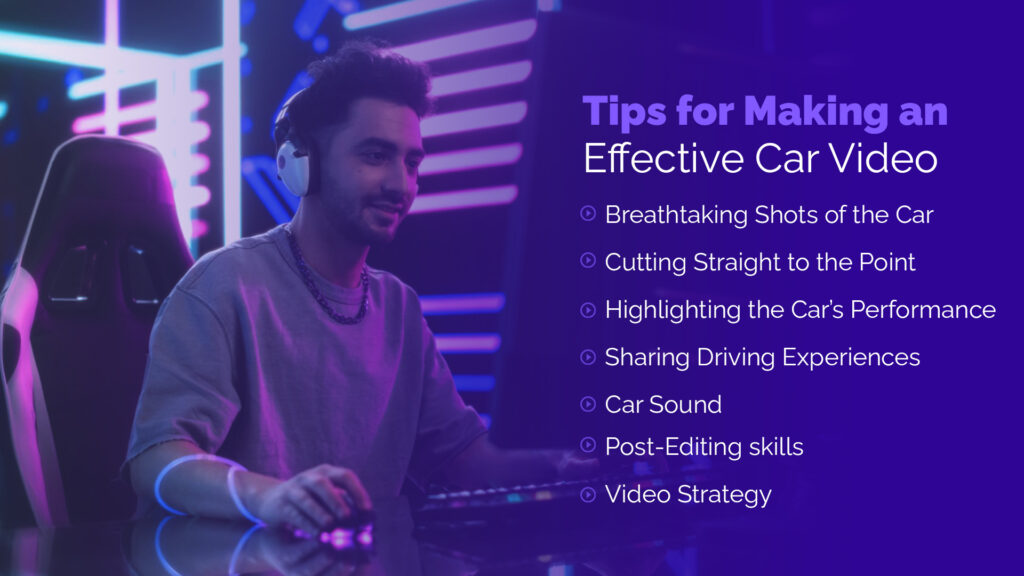
Tips for Effective Car Video Editing
To make your car video shine, here are some tips to remember:
1) Plan Your Shots: Plan out what you want to show. Make sure you capture a variety of shots, from wide shots of the car in action to close-ups of the details.
2) Pacing: Make sure the pacing is dynamic. Do not use long, slow-moving sequences unless it is absolutely necessary for dramatic effect. Use cuts and transitions to keep the energy flowing.
3) Use Music: The right soundtrack will elevate the entire experience. The music should go well with the mood of the video, such as a fast rock track for the action shots or a smooth and calming melody for the scenic road trips.
4) Attention to Detail: Zoom in on unique features such as the dashboard, wheels, and engine to display the car’s intricate design and craftsmanship.
Advanced Techniques in Car Video Editing
For those who want to create truly breathtaking car videos, consider these advanced techniques:
360° Video Editing
360° videos allow viewers to experience a car journey from every angle. Editing this type of footage requires specialized software that can stitch together the video from multiple camera angles.
Virtual Reality (VR)
With VR, car video takes a life of its own, offering experience and interaction through immersion. Cutting VR footage takes advanced software and kit but can give audiences something unique never witnessed before.
Camera Effects
Achieve camera effects such as lens flares and light leaks to give it a cinematic appearance.
Compositing
Compositing is the process of combining several layers of footage to add depth and complexity. It is ideal for focusing on certain features or adding visual effects such as rain or fog.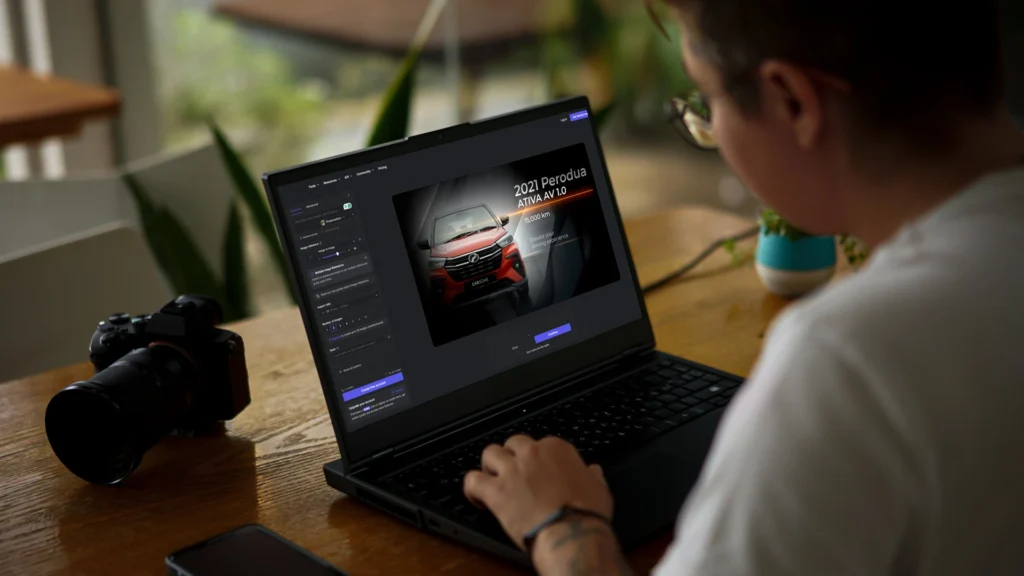
Conclusion
Car video editing transforms simple footage into dynamic and engaging content. Whether you’re an influencer, marketer, or just a car enthusiast, knowing the basic techniques to advanced video editing can help in creating stunning visuals that capture the essence of the car and driving experience. While the entire process takes time, effort and skills choosing new AI based tools can significantly help your dealership create professional car videos without incurring the cost and efforts.


